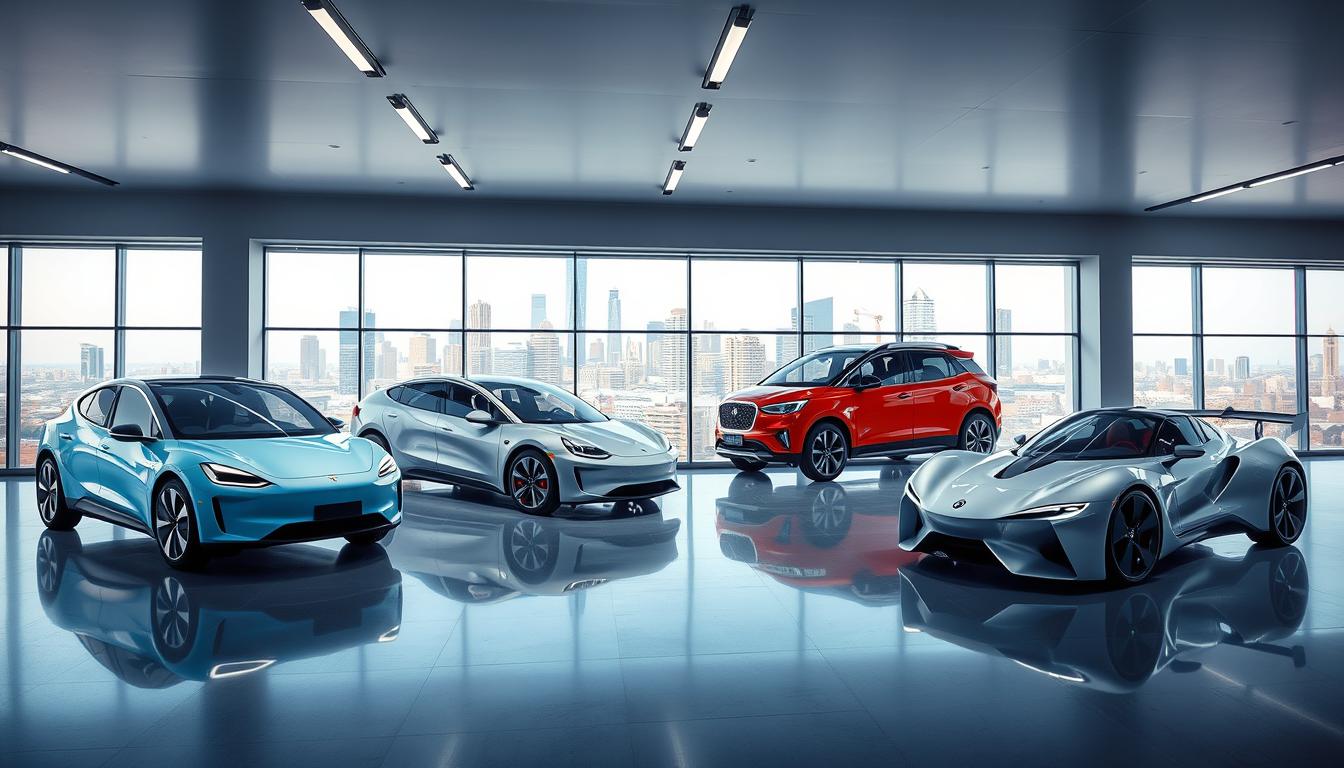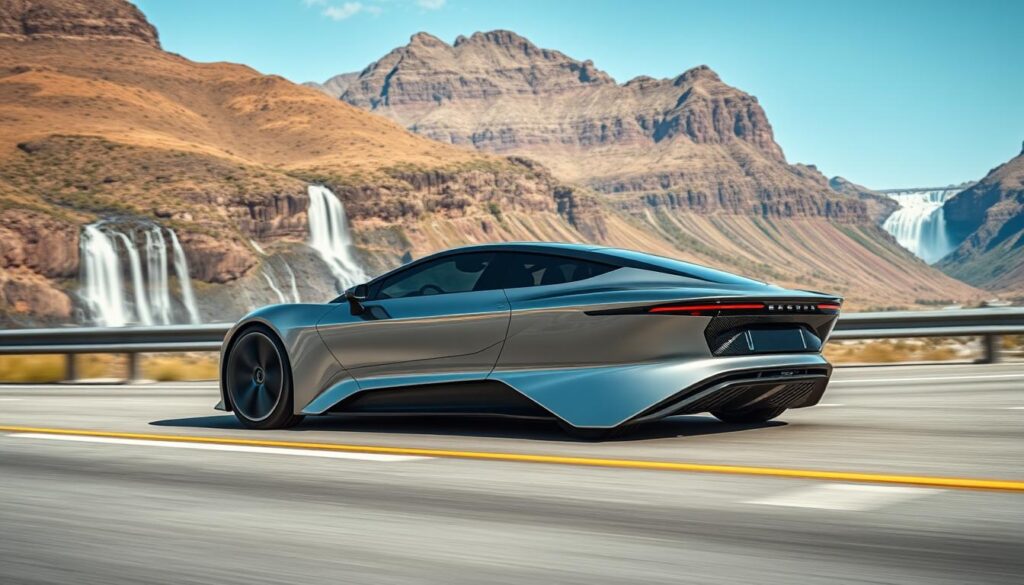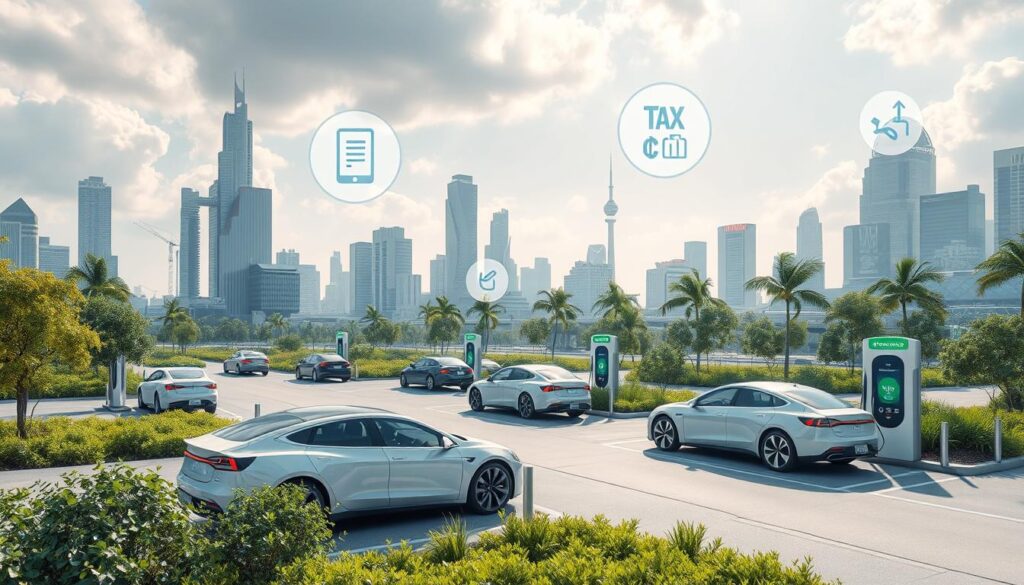
Are you curious about the different types of electric vehicles on the market today? With sales nearing 14 million in 2023, mostly in China, Europe, and the U.S., electric cars are getting cheaper and easier to find. There are many types, like battery electric vehicles (BEVs), plug-in hybrids, and fuel cell electric vehicles (FCEVs), each with its own benefits.
In this detailed guide, we’ll look at the four main electric vehicle types: BEVs, PHEVs, HEVs, and FCEVs. Knowing the differences between these categories will help you choose the right zero-emission car for your next purchase.
Battery electric vehicles (BEVs) run only on electricity and don’t emit any tailpipe emissions. This makes them a true zero-emission choice. Plug-in hybrid electric vehicles (PHEVs) have both a gasoline engine and an electric motor. They can go 20 to 40 miles on electricity alone.
Hybrid electric vehicles (HEVs) also use both engines but can’t be plugged in to recharge. Fuel cell electric vehicles (FCEVs) use hydrogen to make electricity, releasing only water vapor and warm air.
Key Takeaways
- Electric vehicles are categorized into four main types: BEVs, PHEVs, HEVs, and FCEVs
- Battery electric vehicles (BEVs) have a typical driving range of 150 to 400 miles on a single charge
- Plug-in hybrid electric vehicles (PHEVs) can travel 20-40 miles on electricity alone before switching to gasoline
- Hybrid electric vehicles (HEVs) combine a gasoline engine with an electric motor but cannot be plugged in to recharge
- Fuel cell electric vehicles (FCEVs) use hydrogen fuel cells to generate electricity, emitting only water vapor and warm air
- Electric vehicles may qualify for federal tax credits ranging from $3,700 to $7,500, depending on the model
Introduction to Electric Vehicles
Electric vehicles (EVs) are changing the car world. They offer a cleaner and more efficient choice than traditional cars. EVs use electricity to power their engines, leading to a greener future in travel.
Thanks to better batteries and more charging spots, there’s a wide range of EVs. This includes battery electric vehicles (BEVs) and plug-in hybrid electric vehicles (PHEVs). Each type has its own benefits and features.
The journey of electric cars is fascinating. They first appeared in the late 19th century. But, their popularity went up and down over the years.
Now, in the 21st century, electric cars are gaining ground again. This is thanks to better batteries, electric motors, and power electronics.
| Electric Vehicle Type | Key Characteristics |
|---|---|
| Battery Electric Vehicles (BEVs) | Rely solely on a rechargeable battery pack, no internal combustion engine |
| Hybrid Electric Vehicles (HEVs) | Primarily powered by gasoline, with a small battery pack for enhanced efficiency |
| Plug-in Hybrid Electric Vehicles (PHEVs) | Combine an electric traction motor with an internal combustion engine, requiring both charging and gasoline |
As we focus on cutting carbon emissions and fighting climate change, EVs are key. Governments are helping by offering incentives and building more charging spots. The 2009 Copenhagen Summit showed how urgent it is to move towards zero emissions. Electric cars are crucial for a sustainable future.
Battery Electric Vehicles (BEVs)
Battery electric vehicles (BEVs) are all-electric vehicles that run on electricity stored in their batteries. They are zero-emission and are gaining popularity. In 2022, over 5% of the U.S. market was fully electric. BEVs are great for those who care about the environment and want government benefits.
Advantages of BEVs
BEVs have no tailpipe emissions, making the air cleaner and reducing greenhouse gases. They also offer instant torque and smooth acceleration. This makes driving fun and responsive. Most daily trips are within the range of current electric vehicles, making BEVs perfect for daily use.
Examples of BEVs
Some popular BEV models include the Tesla Model 3 and the Nissan Leaf. The Tesla Model 3 is the top-selling all-electric car, with over 645,000 sales by October 2020. The Nissan Leaf has sold over 500,000 units by September 2020. These models show that battery electric vehicles are becoming a common choice.
Charging Infrastructure for BEVs
Building a strong charging equipment network is key for BEVs. The U.S. government has set aside $7.5 billion for public charging stations. This, along with more home and workplace charging, will make owning a BEV easier. It will help more people switch to all-electric vehicles.
Plug-in Hybrid Electric Vehicles (PHEVs)
Plug-in hybrid electric vehicles (PHEVs) are a great choice for those who want electric power and the range of a gas engine. They have a special powertrain that switches between electric and gas modes. This makes them a practical option for those who want both efficiency and flexibility.
How PHEVs Work
PHEVs have both an electric motor and a gas engine. They can run on electricity for a while before switching to gas when the battery is low. Today’s PHEVs can go from 15 to 60+ miles on electric power alone, perfect for daily trips.
When the battery is empty, the gas engine kicks in. This lets you go further without worrying about running out of power.
Benefits of PHEVs
PHEVs are good for the environment and your wallet. They cost just $0.02 to $0.04 per mile on electric power. This is much cheaper than gas cars, which cost $0.10 to $0.15 per mile.
Many governments also give incentives and tax credits to PHEV owners. This makes them even more appealing financially.
PHEVs are fast because of their electric and gas power. They also offer the convenience of charging at home and refueling at gas stations. This makes them a great choice for many drivers.
Popular PHEV Models
Many car makers offer PHEV models. Here are some of the most popular ones:
- BYD Song DM: The world’s best-selling plug-in hybrid SUV series, with over 1,050,000 cumulative sales as of December 2023.
- Mitsubishi Outlander PHEV: With global cumulative sales reaching 290,000 units as of September 2021.
- Chevrolet Volt: The world’s top-selling plug-in hybrid until September 2018.
| Country | PHEV Stock (December 2019) |
|---|---|
| China | 767,900 |
| United States | 567,740 |
| United Kingdom | 159,910 |
By December 2019, there were 2.4 million PHEVs worldwide. They offer a mix of electric efficiency and gas convenience. This makes them a key option in the changing car market.
Hybrid Electric Vehicles (HEVs)
Hybrid electric vehicles (HEVs) are changing the car world. They offer a green choice instead of gas cars. These cars use both electric and gas power, making them fuel-efficient and eco-friendly.
HEVs work thanks to smart tech. Their batteries get charged by the engine and regenerative braking. This means they use less fuel and make fewer emissions.
The Rise of the Toyota Prius
The Toyota Prius is a big name in HEVs. It started in 1997 and has sold over 5 million units by September 2022. It’s the top-selling hybrid car globally.
Fuel Efficiency Advantages
HEVs save a lot of fuel. They use electric and gas power together. This can make them 25% to 35% more fuel-efficient than non-hybrid cars.
| Region | Hybrid Electric Vehicle Sales |
|---|---|
| Worldwide | Over 17 million units (as of April 2020) |
| Japan | 7.5 million units (as of March 2018) |
| United States | 5.8 million units (as of December 2020) |
| Europe | 3.0 million units (as of July 2020) |
The table shows HEV sales worldwide. Japan loves them, with 19.0% of cars being hybrids. The U.S. and Europe also see more hybrids, showing they’re popular everywhere.
Fuel Cell Electric Vehicles (FCEVs)
Fuel Cell Electric Vehicles (FCEVs) are a clean and efficient alternative to traditional cars. They run on hydrogen gas and produce electricity through a fuel cell. This process creates electricity and only water vapor as a byproduct.
By December 2020, 31,225 passenger FCEVs had been sold worldwide. Models like the Toyota Mirai and Hyundai Nexo are available in some markets. Toyota has shared its hydrogen fuel cell patents with competitors since 2015.
Advantages of FCEVs
FCEVs are great for the environment because they only emit water vapor. They also have longer ranges and faster refueling times than battery electric vehicles. The Hyundai Nexo, for example, has an EPA rating of 61 mpg-e combined.
Challenges Facing FCEV Adoption
Despite their benefits, FCEVs face several challenges. One major issue is the lack of hydrogen refueling stations. By 2020, there were fewer than fifty in the U.S. The high cost of the vehicles and hydrogen also makes them hard to access.
Producing hydrogen for FCEVs can also harm the environment, especially if fossil fuels are used. But, efforts are underway to make hydrogen from renewable sources. This could make FCEVs more sustainable.
“The strategic use of hydrogen in FCEVs enhances energy diversification, reducing reliance on a single energy source.” – Industry Expert
In summary, FCEVs are a promising way to cut down on transportation emissions. However, we need more investment in infrastructure and research. As technology improves and renewable hydrogen becomes more common, FCEVs could be key to a sustainable future.
Range and Battery Capacity of Modern Electric Cars
The range of all-electric cars has grown a lot lately. Many models now go 150 to 300 miles on one charge. This meets the needs of most drivers for daily trips or casual outings.
Some long-range EVs, like the Tesla Model S Long Range, can go 379 miles on a full charge. The Mercedes-Benz EQS saloon goes even further, with a WLTP range of 487 miles. These long ranges help reduce the worry of running out of charge before reaching a destination.

Battery size is key to an electric car’s range. In 2023, electric vehicle batteries ranged from 21 to 123 kWh, averaging 80 kWh. That year, almost 2,000 GWh of lithium-ion batteries were made for electric vehicles, with 772 GWh for EVs.
Electric car batteries are getting better and lasting longer. They can last up to 10 years, with some models staying strong even after 100,000 to 200,000 miles. To keep batteries healthy, charge to 80% daily and keep the charge between 20-80% when not in use for a long time.
| Battery Type | Specific Energy (W·h/kg) | Characteristics |
|---|---|---|
| Lithium-ion (Li-NMC, LFP, Li-NCA) | 100-265 | Dominant in BEV market, high energy density |
| Lithium Iron Phosphate (LFP) | 90-160 | 41% global market share for BEVs in 2023, high safety profile |
| Lithium Titanate (LTO) | 50-80 | High safety, can exceed 10,000 charge-discharge cycles |
| Nickel-Metal Hydride (NiMH) | 30-80 | Long life when used properly |
Charging Methods for Electric Vehicles
As electric vehicles (EVs) become more popular, it’s key to know about different charging methods. EV owners can choose from level 1, level 2, and dc fast charging. Each method has its own speed, convenience, and availability, meeting the needs of EV drivers.
Level 1, Level 2, and DC Fast Charging
Level 1 charging uses a standard 120V outlet. It takes 8-12 hours to fully charge an EV, adding 6 to 8 kilometers of range per hour. It’s best for charging at home overnight.
Level 2 charging uses 240V and charges faster. You’ll find these chargers in public places. They cut down charging time, making them handy for EV owners.
DC fast charging is the fastest method. It can charge an EV up to 80% in 20 minutes. These chargers are perfect for long trips and quick charges.
| Charging Level | Voltage | Power Output | Charging Time |
|---|---|---|---|
| Level 1 | 120V | 3-6 kW | 8-12 hours |
| Level 2 | 240V | 7 kW or 22 kW | 4-8 hours |
| DC Fast Charging | 480V+ | 50 kW – 100+ kW | 20-60 minutes |
Charging at Home vs. Public Charging Stations
Charging at home is the most convenient and cost-effective option. 64% of EV drivers charge at home regularly. Level 1 and level 2 chargers are common for home use.
Public charging stations offer level 2 and dc fast charging. 31% of EV users charge at public stations. You can find them at workplaces, gas stations, and shopping malls. They’re great for topping up while away from home.
Government Incentives and Tax Credits for Electric Cars
As we move towards a greener future, governments worldwide are giving incentives for electric cars. These incentives make electric vehicles more affordable and encourage people to switch to cleaner transport.

In the U.S., the federal government offers up to $7,500 in tax credits for electric and plug-in hybrid vehicles. This credit has helped grow the electric vehicle market, making EVs more affordable for consumers.
Federal Tax Credits in the United States
The U.S. federal tax credits for electric vehicles depend on the car’s battery size. The credit starts at $2,500 for cars with at least 5 kWh batteries. It increases by $417 for every additional kWh, up to $7,500. But, these credits phase out when an automaker sells 200,000 qualifying vehicles.
| Battery Capacity | Federal Tax Credit |
|---|---|
| 5 kWh | $2,500 |
| 5-16 kWh | $2,500 + $417 per additional kWh |
| 16 kWh and above | $7,500 |
Businesses and tax-exempt organizations can also get a Commercial Clean Vehicle Credit of up to $40,000. This credit is for electric commercial vehicles, encouraging their use in the business sector.
State-level Incentives and Rebates
Many U.S. states offer their own incentives and rebates for electric vehicles. States like California, New York, and Colorado provide up to $5,000 in additional tax credits for EVs and plug-in hybrids.
Electric vehicle owners save approximately one third on maintenance costs compared to traditional internal combustion engine vehicles.
These state incentives, along with federal credits, lower the cost of buying an electric vehicle. This makes EVs more competitive with gas cars. Some states also offer lower electricity rates for charging EVs during off-peak hours, cutting down on costs even more.
By offering these incentives, the U.S. is pushing for more electric vehicles. This helps reduce greenhouse gas emissions and improves air quality in cities. As more people choose EVs, the country gets closer to its environmental goals.
Modern Electric Car Categories: A Comprehensive Comparison
Electric vehicles are becoming more popular. It’s important to know the differences between the various types. Each electric car has its own features, benefits, and drawbacks. This makes it key for buyers to compare and choose the right one for their needs.
When picking an electric car, several factors matter. These include driving range, charging needs, price, and personal preferences. Battery Electric Vehicles (BEVs) are great for those who want zero emissions and long ranges. For example, the Tesla Model 3 can go up to 358 miles on a single charge.
Plug-in Hybrid Electric Vehicles (PHEVs) and Hybrid Electric Vehicles (HEVs) offer a mix of electric and traditional tech. They’re good for those who want electric car benefits but also need a gasoline engine. The Toyota Rav4 Prime, for instance, can go about 42 miles on electric before switching to gas for an extra 550 miles.
Choosing the Right Electric Car Category for Your Needs
Think about your daily driving and long-term goals to pick the right electric car category. If your commute fits within a BEV’s range and you have charging access, a BEV might be best. But if you often take long trips or live where charging is scarce, a PHEV or HEV could be more practical.
| Electric Car Category | Range (miles) | Charging Time (Level 2) | Starting Price (USD) |
|---|---|---|---|
| Tesla Model 3 | 272 – 358 | 8 hours | $41,630 |
| Volkswagen ID.4 | 250 – 260 | 7.5 hours | $40,290 |
| Hyundai Ioniq 5 | 220 – 303 | 6.5 hours | $41,450 |
| Toyota Rav4 Prime | 42 (electric) + 550 (gas-hybrid) | 4.5 hours | $41,590 |
Price is a big factor in choosing an electric car. Some models, like the Tesla Model Y, cost more. But, there are also affordable options like the Chevrolet Bolt, starting under $30,000. Many electric cars also qualify for tax credits and state incentives, making them more affordable for many.
Conclusion
Electric vehicles are becoming more popular, with many types available. Battery electric vehicles (BEVs) are known for being efficient and not emitting any pollution. They are expected to sell around 14 million in 2023, mainly in China, Europe, and the US.
Plug-in hybrid electric vehicles (PHEVs) can go further by using both fuel and electric power. Hybrid electric vehicles (HEVs) also improve fuel use, especially in cities. This leads to less pollution than regular cars.
But, there are hurdles to electric vehicles becoming common. Not enough charging spots and higher costs are big issues. Also, they don’t go as far as gas cars, and battery tech needs work.
Yet, scientists and companies are working hard to fix these problems. They aim to make batteries better, increase range, and cut down on weight and cost. They also want to make charging faster.
Government support is key to making electric cars more appealing. They offer tax breaks and rebates to buy electric vehicles. As tech improves and more charging spots appear, electric cars are getting more popular. They help people reduce their environmental footprint.
Knowing about the different electric cars helps drivers choose the right one. This choice supports a greener future for transportation.
FAQ
What are the main categories of electric vehicles?
Electric vehicles fall into four main categories. These are Battery Electric Vehicles (BEVs), Plug-in Hybrid Electric Vehicles (PHEVs), Hybrid Electric Vehicles (HEVs), and Fuel Cell Electric Vehicles (FCEVs).
How do Battery Electric Vehicles (BEVs) work?
BEVs run on electricity stored in their batteries. They get charged from outside sources. They are clean, save money, and start fast.
What are the benefits of Plug-in Hybrid Electric Vehicles (PHEVs)?
PHEVs offer many benefits. They can use electric or gas power, cut down on emissions, and get government help. They switch to gas when the battery is low.
How do Hybrid Electric Vehicles (HEVs) improve fuel efficiency?
HEVs use both electric and gas power. The engine charges the batteries and regenerative braking helps. This makes them more fuel-efficient and cleaner than gas cars.
What are the advantages and challenges of Fuel Cell Electric Vehicles (FCEVs)?
FCEVs use hydrogen to make electricity. They are clean, fast to refuel, and have long ranges. But, they need more hydrogen stations, cost more, and hydrogen production is a concern.
What is the average range of modern electric vehicles?
Electric vehicles usually go about 377 km. Some, like the Mercedes-Benz EQS 450+ and Lucid Air Grand Touring, can go over 600 km.
What are the different charging methods for electric vehicles?
Electric vehicles can charge in several ways. Level 1 and Level 2 are for home use. DC fast charging is for quick charges at public stations.
Are there government incentives for purchasing electric vehicles?
Yes, governments offer incentives for EVs. In the U.S., you can get a ,700 to ,500 tax credit. Many states also have their own deals.
What factors should I consider when choosing an electric car?
Think about range, charging, price, and what you like. BEVs are good for the planet. PHEVs and HEVs offer a mix. FCEVs are new but face challenges.






